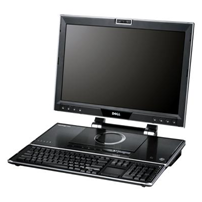Portable computers are productivity-enhancement tools that allow busy executives to carry their office work with them. Thus, the time spent in waiting for planes, trains, etc. can be used productively as the office travels with the executive.
The critical criterion for a portable computer is size. The smaller the size, the easier it is to carry around. Several innovative techniques are being used to reduce size, some of which will be discussed here.
The VDU has to be compact, light, and use less power (these computers are meant to be used on the road and, hence, run on batteries). For this, LCDs (Liquid Crystal Displays—the kind you see in calculators and watches) that are light and consume very little power, are used.
The number of keys on the keyboard are reduced, and the keys are made to perform multiple functions. As the keyboard cannot be shrunk indefinitely, other devices like the mouse, light pens, etc. are used.
The size of hard disk is reduced. Hard disks as small as 2.5" in diameter but capable of storing large quantities of data and weighing only 300 gms are available.
The size of hard disk is reduced. Hard disks as small as 2.5" in diameter but capable of storing large quantities of data and weighing only 300 gms are available.
There are however, problems which have to be tackled. When using portables in office, the user would like to utilize resources of the desktop. The desktop can be used by swapping its hardware with that of the portable. One option is to have a desktop PC in the office and use the portable while travelling. But this involves swapping disks in and out to transfer data. Some portables overcome this problem by providing docking stations. All you have to do now is to plug the portable into the docking station, and you can use normal screens and keyboards. This has the added advantage of avoiding duplicate system units.
A Portable Computer
If carrying the office with you is to be made a reality, the portable should allow you to communicate with your base office (which is stationary) while you are on the move. Most portables allow modems to be fitted inside them or provide sockets for an external connection to a modem.
Note: A modem which stands for modulation-demodulation is a device that converts the digital pulses into analog pulses when telephone lines are used to transmit data.

